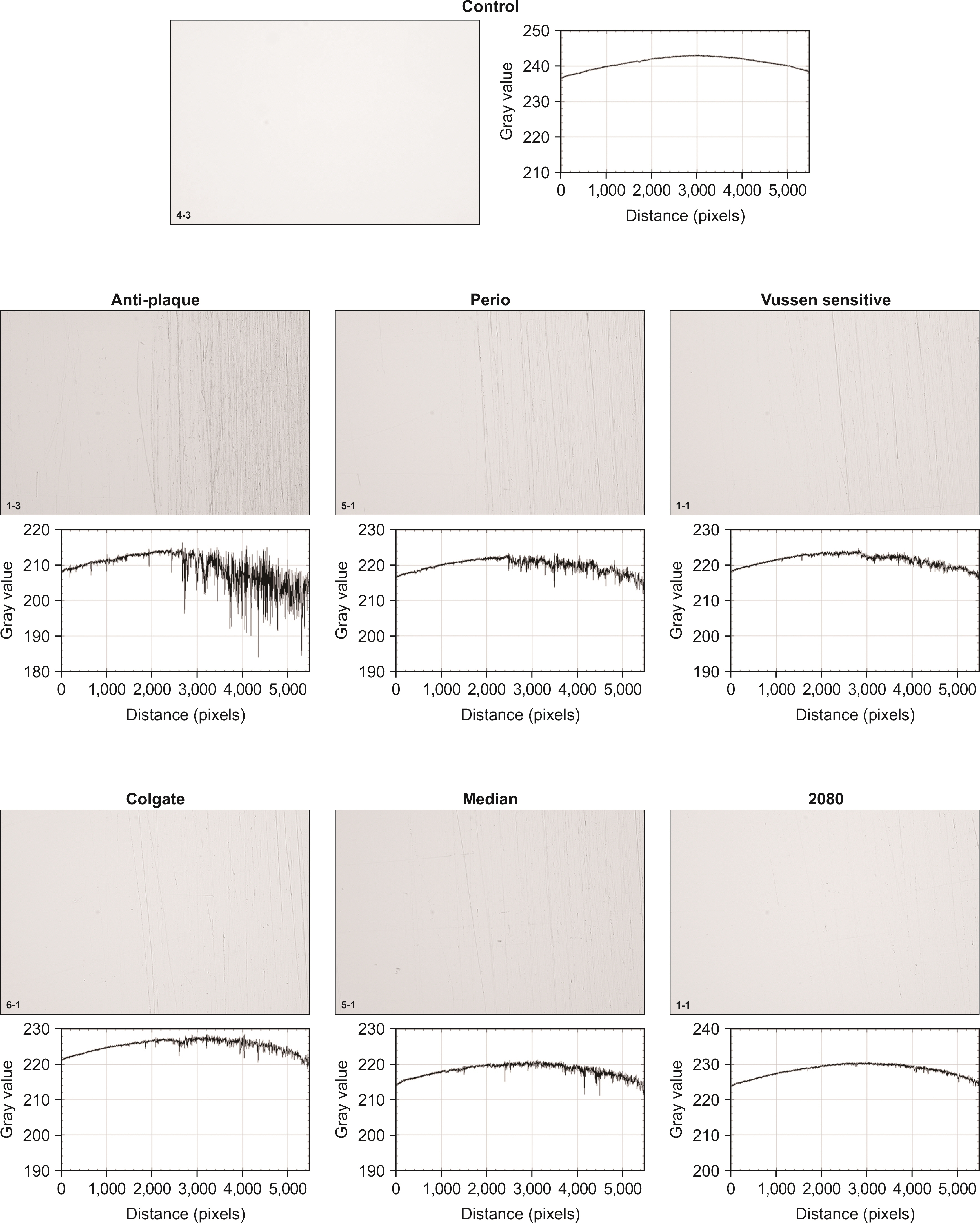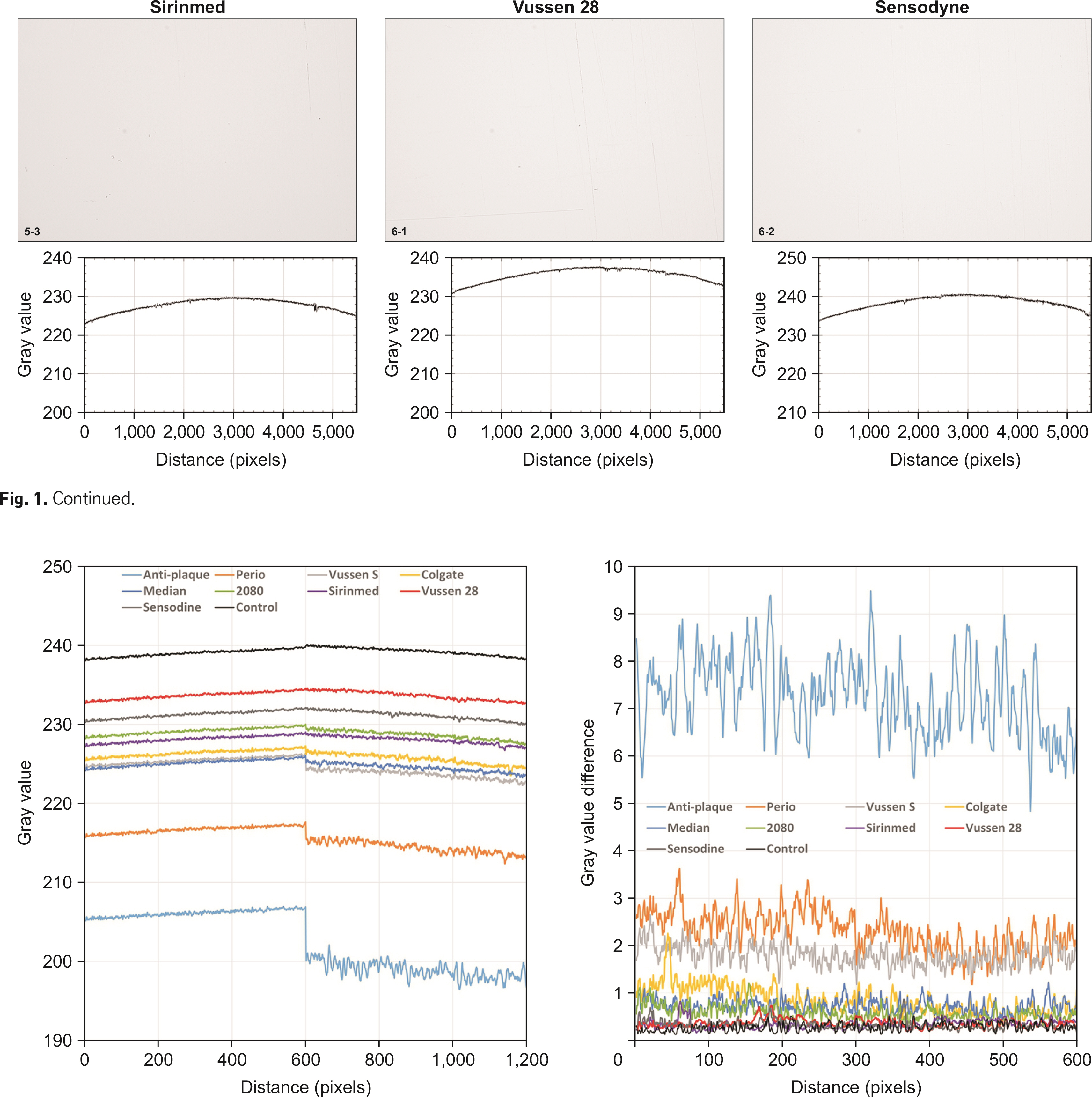J Korean Acad Oral Health.
2023 Dec;47(4):160-166. 10.11149/jkaoh.2023.47.4.160.
Evaluation of toothpaste abrasivity using acrylic and spectrophotometry
- Affiliations
-
- 1Department of Preventive & Community Dentistry, School of Dentistry, Pusan National University, Yangsan, Korea
- 2BK21 PLUS Project, Pusan National University, Yangsan, Korea
- KMID: 2550168
- DOI: http://doi.org/10.11149/jkaoh.2023.47.4.160
Abstract
Objectives
This study aimed to develop a method for objectively evaluating toothpaste abrasivity, enabling a direct comparison between different toothpastes.
Methods
Nine commercially available toothpaste variants were selected, and 8 mm thick acrylic specimens were allocated to each toothpaste treatment group (n=7). A control group without toothpaste was also included. Specimens and toothbrushes were mounted on the V8 Cross brushing machine, and toothpaste (0.05-0.1 g) was applied for 20 strokes under a 200 g load and 1 Hz speed. The surface wear was measured at an absorbance of 600 nm in a UV-Vis spectrophotometer. Specimens were then photographed with a polarized light microscope, and the gray value of the worn brushed part was obtained through image analysis using Image J software. A one-way ANOVA followed by Bonferroni’s post-hoc test was employed for analyzing absorbance and gray value differences among the toothpaste groups. The correlation between absorbance and gray value was assessed using Pearson’s correlation analysis.
Results
Significant differences were noted in absorbance and gray values across the toothpaste groups (P<0.05), and a strong correlation was observed between the absorbance and the values from the images analyzed (r=0.948, P<0.001). The wear rankings based on absorbance and image analysis values were mostly the same.
Conclusions
This study introduces a direct and objective method for evaluating toothpaste abrasion, offering users objective information on different toothpaste types.
Figure
Reference
-
References
1. Drug Safety. Drug Information Search [Internet]. Available from: https://nedrug.mfds.go.kr/searchDrug. [Korean]. cited 2023 Mar 20.2. Standard manufacturing standards for quasi-drugs [Internet]. Available from: https://www.law.go.kr/행정규칙/의약외품표준제조기준. [Korean]. cited 2023 Sep 17.3. Camargo IM, Saiki M, Vasconcellos MB, Avila DM. 2001; Abrasiveness evaluation of silica and calcium carbonate used in the production of dentifrices. J Cosmet Sci. 52:163–167. DOI: 10.1007/978-3-0348-8245-3. PMID: 11413496.4. Orchardson R, Gillam DG. 2006; Managing dentin hypersensitivity. J Am Dent Assoc. 137:990–8. DOI: 10.14219/jada.archive.2006.0321. PMID: 16803826.5. Hara AT. TurssiCP. 2017; Baking soda as an abrasive in toothpastes: Mechanism of action and safety and effectiveness considerations. J Am Dent Assoc. 148:S27–33. DOI: 10.1016/j.adaj.2017.09.007. PMID: 29056187.6. Rapid increase in patients with cervical abrasion, 'Toothpaste abrasion labeling' has been unknown for over 10 years [Internet]. Available from: https://news.kdha.or.kr/news/articleView.html?idxno=8441. [Korean]. cited 2023 Nov 01.7. Park YS. 2019. Research on toothpaste abrasivity analytic method and its information application. National Institute of Food and Drug Safety Evaluation;Cheongju: [Korean].8. Kim BI, Park DY. Oral Health Textbook Editorial Committee. 2016. Oral care products. Preventive Dentistry. 1st ed. DeahanNarae Publishing Inc.;Seoul: p. 84–89. [Korean]. DOI: 10.29252/ijpd.12.1.71.9. Ha JE, Kang YJ, Jin BH, Paik DI, Bae KH. 2011; Relative tooth abrasivity of the dentifrices marketed in Korea. J Korean Acad Oral Health. 35:18–22. [Korean].10. Kim DW. 2017. Comparison of dentin abrasivity between electric toothbrush and manual toothbrush with various [master's thesis]. Seoul National University;Seoul: [Korean].11. ISO 11609:2017(E) Dentistry - Dentifrices - Requirements, test methods and marking.12. Hefferren JJ. 1976; A laboratory method for assessment of dentrifrice abrasivity. J Dent Res. 55:563–73. DOI: 10.1177/00220345760550040301. PMID: 1064599.13. Vicentini BC, Braga SR, Sobral MA. 2007; The measurement in vitro of dentine abrasion by toothpastes. Int Dent J. 57:314–318. DOI: 10.1111/j.1875-595X.2007.tb00139.x. PMID: 17992916.14. KS P ISO/TR14569-1(2019.11.25.) Dental materials ─ Guidance on testing wear ─ Part 1: Wear by toothbrushing. [Korean].15. KS P ISO 11609:2010 Dentistry - Dentifrices - Requirements, test methods and marking (2021 confirmation). [Korean].16. Larena A, Pinto G. 1993; The effect of surface roughness and crystallinity on the light scattering of polyethylene tubular blown films. Polym Eng Sci. 33:742–747. DOI: 10.1002/pen.760331204.17. Begot C, Desnier I, Daudin JD, Labadie JC, Lebert A. 1996; Recommendations for calculating growth parameters by optical density measurements. J Microbiol Methods. 25:225–32. DOI: 10.1016/0167-7012(95)00090-9.18. Kang JK, Kim SH, Yoo EM, Choi HS, Choi YR, Kim KM. 2012; Surface changes of denture base resin according to two toothpastes and a kitchen detergent. J Korean Soc Dent Hyg. 12:611–620. DOI: 10.13065/jksdh.2012.12.3.611.
- Full Text Links
- Actions
-
Cited
- CITED
-
- Close
- Share
- Similar articles
-
- A new in vitro method for evaluating the antimicrobial activity of toothpaste
- The effects of hydroxyapatite toothpaste on tooth hypersensitivity
- Evaluation of Total and Soluble Fluoride Concentrations in Ten Toothpastes for Children
- Changes in public recognition of parabens on twitter and the research status of parabens related to toothpaste
- Impact of combined at-home bleaching and whitening toothpaste use on the surface and color of a composite resin



